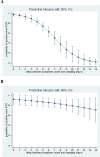Urine PCR testing as an effective method for early diagnosis of leptospirosis
- PMID: 41051209
- PMCID: PMC12584711
- DOI: 10.1128/spectrum.01185-25
Urine PCR testing as an effective method for early diagnosis of leptospirosis
Abstract
The role of urine PCR for leptospirosis diagnosis in the first week is controversial due to assumed limited urine excretion. This study analyzed the prescribing practices and sensitivity of blood and urine Leptospira PCR, particularly in early stages of infection. A study was conducted on adult patients diagnosed with leptospirosis in French Guiana between 2016 and 2022 by positive Leptospira PCR, or titer of Micro-Agglutination Test > 1/200, or positive IgM with no alternative diagnosis. The timing of PCR tests and their sensitivity were analyzed. A multivariate logistic regression was performed to identify the factors associated with the sensitivity and predict the probability of having a positive result. Among 188 analyzed patients, 137 (73%) and 61 (32%) underwent blood and urine PCR tests with a median (IQR) delay since symptoms onset of 5 (3-7) and 6 (5-8) days, respectively. The overall sensitivity of urine PCR was 84% (vs 70% for blood PCR, P = 0.04). Of the 25 patients sampled the same day in the first week, eight had negative blood PCR but positive urine PCR. Contrary to urine, the sensitivity of blood PCR significantly decreased with time since symptom onset (aOR 0.56 per day, 95% CI [0.44-0.73]). The predicted probability of positive urine PCR appeared higher than that of blood PCR as soon as 4 days after symptom onset. Urine PCR should be considered at the first consultation, alongside blood PCR.
Importance: The study investigates the utility of urinary PCR for diagnosing leptospirosis, focusing on its early sensitivity. Conducted in French Guiana between 2016 and 2022, the research analyzed prescribing practices and the sensitivity of blood and urine PCR tests in adult patients. Results indicated that while underutilized, urinary PCR demonstrated high sensitivity from the early days of symptom onset, achieving 84% sensitivity compared to 70% for blood PCR. The sensitivity of blood PCR decreased over time, whereas that of urinary PCR remained stable. The study advocates for the routine inclusion of urinary PCR in the diagnostic workup from the first week of illness to enhance early leptospirosis detection.
Keywords: PCR; diagnosis; leptospirosis; urine.
Conflict of interest statement
The authors declare no conflict of interest.
Figures




References
-
- Warnasekara J, Srimantha S, Kappagoda C, Jayasundara D, Senevirathna I, Matthias M, Agampodi S, Vinetz JM. 2022. Diagnostic method-based underestimation of leptospirosis in clinical and research settings; an experience from a large prospective study in a high endemic setting. PLoS Negl Trop Dis 16:e0010331. doi: 10.1371/journal.pntd.0010331 - DOI - PMC - PubMed
-
- Valente M, Bramugy J, Keddie SH, Hopkins H, Bassat Q, Baerenbold O, Bradley J, Falconer J, Keogh RH, Newton PN, Picardeau M, Crump JA. 2024. Diagnosis of human leptospirosis: systematic review and meta-analysis of the diagnostic accuracy of the Leptospira microscopic agglutination test, PCR targeting Lfb1, and IgM ELISA to Leptospira fainei serovar Hurstbridge. BMC Infect Dis 24:168. doi: 10.1186/s12879-023-08935-0 - DOI - PMC - PubMed
-
- Cunha M, Costa F, Ribeiro GS, Carvalho MS, Reis RB, Nery N Jr, Pischel L, Gouveia EL, Santos AC, Queiroz A, Wunder EA Jr, Reis MG, Diggle PJ, Ko AI. 2022. Rainfall and other meteorological factors as drivers of urban transmission of leptospirosis. PLoS Negl Trop Dis 16:e0007507. doi: 10.1371/journal.pntd.0007507 - DOI - PMC - PubMed
MeSH terms
LinkOut - more resources
Full Text Sources

